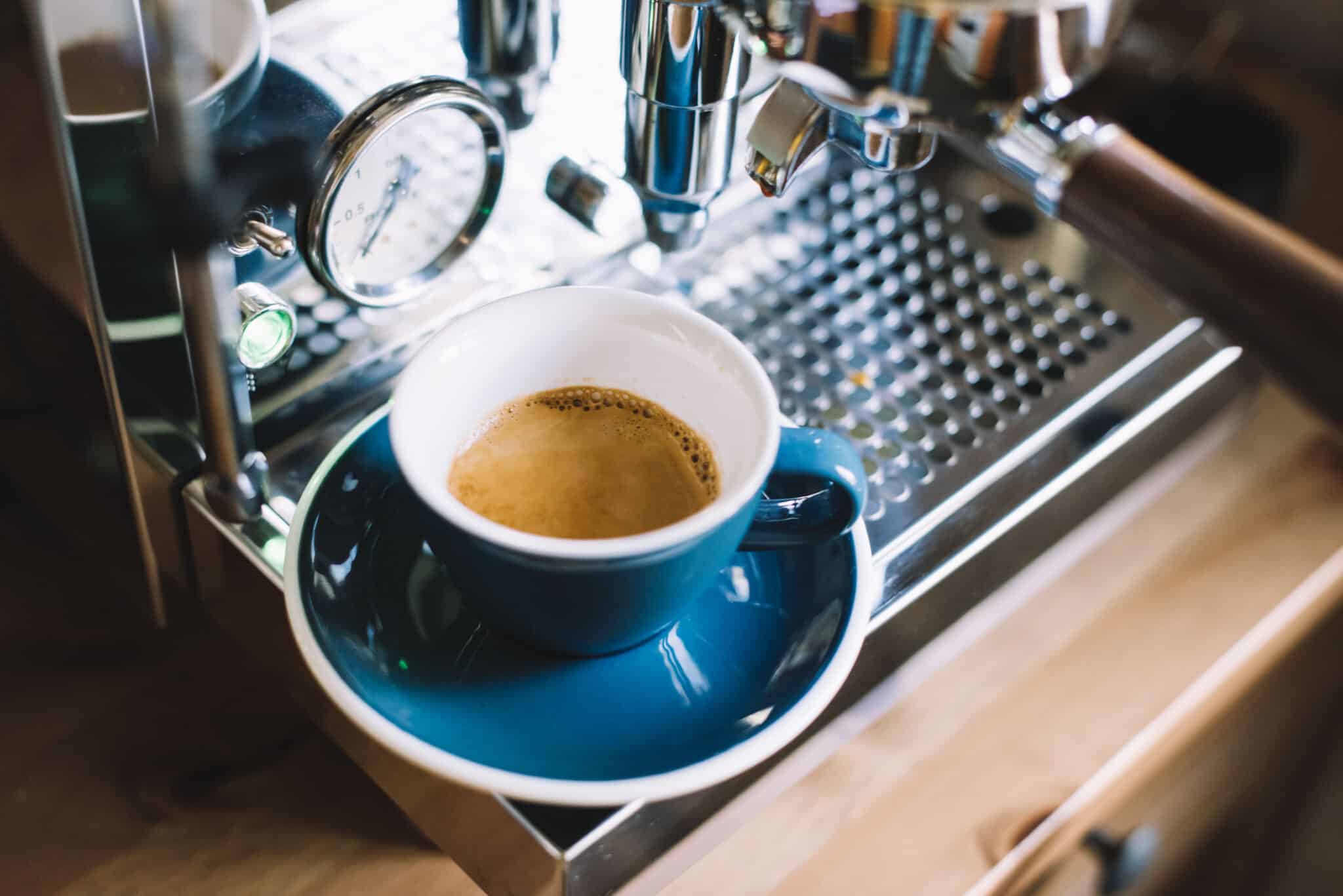The flat white has become a staple in coffee culture because of its velvety microfoam and rich, bold espresso. Originally created in either Australia or New Zealand, this espresso drink is known for its strong coffee flavor and smooth texture.
If you want to make a flat white at home, all you need is the right gear and a little practice. Here, we’ll show you what machines and ingredients you need to recreate this cafe favorite in your own kitchen.
What Is a Flat White?
A flat white is a double shot of espresso topped with steamed milk.
Compared to other espresso drinks, it stands out with its rich coffee flavor and smooth texture. And, unlike a latte, which has more milk, or a cappuccino, which has more foam, a flat white strikes a middle ground between coffee and milk.
Brewing the Perfect Espresso for a Flat White
The foundation of a great flat white is a strong, well-extracted espresso. So, whether you use an espresso machine or another method, the goal is a balanced shot with a smooth finish.
Here’s how to choose the best espresso setup for your home:
Espresso Machine
The best way to make an authentic flat white is with an espresso machine. A good machine allows you to pull a proper double shot with balanced extraction and rich crema.
Look for an espresso machine with a built-in steam wand, as this will help you create microfoam—steamed milk with tiny, velvety bubbles. Microfoam blends smoothly with espresso, giving a flat white its signature silky texture.
Some espresso machines also come with adjustable settings for water pressure and temperature control, which can refine the flavor of your espresso even further.
One great option for home baristas looking for convenience is the Philips 1200 Fully Automatic Espresso Machine with Milk Frother. It grinds fresh beans at the touch of a button and features a classic milk frother, making it easy to get smooth, creamy steamed milk for flat whites.
On the other hand, if you’re looking for a more compact alternative, the CASABREWS Espresso Machine 20 Bar offers professional-grade pressure and a built-in steam wand to help achieve the perfect milk texture.
Nespresso & Pod Machines
For those who prefer convenience, Nespresso machines or other pod-based systems can be a great option. While they don’t offer the same hands-on control as an espresso machine, some models produce a concentrated espresso shot that works well in flat whites.
If you’re looking into a Nespresso machine, the Nespresso Vertuo Next Deluxe is an excellent choice. It brews coffee and espresso, and it comes with the Aeroccino 3 milk frother, making it easy to create velvety steamed milk for your flat white.
Aeropress
If you don’t have an espresso machine but still want strong coffee for your flat white, an Aeropress single-cup coffee maker is an excellent alternative. Though this device only makes one drink at a time, it can produce a concentrated brew with bold flavors similar to what you’d expect from an espresso shot.
To get the best results, use a fine-grind coffee and apply firm pressure when brewing to extract as much richness as possible.
Moka Pot
A Bialetti Moka Pot offers another way to brew strong coffee if you’re missing an espresso machine. Though it lacks the pressure needed to create crema like traditional espresso machines do, it still delivers deep, bold flavors that pair well with steamed milk.
If using a Moka pot for your flat white, grind your coffee slightly finer than drip coffee, but not as fine as espresso, to get the best extraction possible.
Essential Gear for Making a Flat White
While technique is important, the right equipment makes all the difference when making a flat white at home. Here are our picks for the right coffee accessories to add to your kitchen so you can make the perfect flat white at home.
Coffee Grinder
Freshly ground beans make all the difference when brewing espresso-based drinks at home. A burr grinder is the best option because it creates an even grind size, which means better extraction and more balanced flavors in your coffee. Espresso requires an extra-fine grind, so having adjustable settings on your grinder is a must.
The SHARDOR Electric Burr Coffee Grinder offers 16 precise grind settings and ensures uniform grounds for optimal flavor extraction. Another plus is its large capacity, which makes it easy to prepare multiple shots at once without constantly refilling beans.
Milk Frother
Steaming milk properly is key to nailing the texture of a flat white. If your machine doesn’t have a built-in steam wand, you can use a standalone milk frother instead. Handheld frothers are compact and easy to use, while electric frothers take care of both heating and foaming automatically.
You can also use a French press by warming your milk first and then pumping the plunger rapidly to create foam manually. Regardless of which method you choose, aim for creamy microfoam rather than stiff froth to maintain the drink’s signature texture.
Milk Frothing Pitcher
If you do have an espresso machine with a built-in frothing wand, a milk frothing pitcher provides excellent control over milk texture and temperature. Using one of these pitchers takes a bit of practice, but it creates a true barista-like experience when making flat whites at home. Its spouted design also helps with precise pouring—ideal for flat whites and even simple latte art.
Kitchen Scale
Precision matters when making flat whites at home. This is why you should measure everything. Measuring your coffee grounds ensures consistency in flavor and strength every time you brew your espresso shot.
Luckily, a digital kitchen scale allows you to weigh out your beans accurately so you can achieve optimal extraction ratios without guessing measurements each time you pull a shot.
One option is the KitchenAid 11lb Glass Surface Digital Kitchen Food Scale. This scale is sleek and highly functional, giving you precision control over dosing your coffee grinds—an essential step in pulling consistently great espresso shots for flat whites.
Thermometer
Milk should be heated between 130 degrees and 150 degrees F for steaming. This is hot enough to enhance the milk’s sweetness but not so hot that it scalds or loses its creamy texture. A thermometer helps monitor temperature while steaming or frothing so that you don’t overheat your milk and ruin its delicate taste and structure.
For accurate temperature readings while steaming or frothing, the Yacumama Digital Water Thermometer offers instant readouts with waterproof durability—perfect for checking milk temperature quickly before pouring into your espresso drinks.
How to Make a Flat White at Home
Making a flat white at home is easier than you may think. With the right technique, you can achieve the smooth microfoam and rich espresso flavor that define this drink.
Pulling the Espresso Shot
Here’s a quick process for making espresso:
- Grind fresh beans fine, like table salt
- Measure out 18–20g for a double shot
- Tamp ground coffee evenly in the portafilter (the piece of equipment with the handle that holds the ground coffee)
- Pull shot in 25–30 seconds
The goal is a rich, bold espresso with a slight crema on top.
Steaming the Milk Correctly
Good milk texture is what makes a flat white stand out. Here’s how to get the right milk for your flat white:
- Pour cold milk into a steaming pitcher, filling it about one-third full
- If using a steam wand, place it just under the surface and turn it on, allowing air to gently incorporate into the milk for a few seconds before submerging the wand deeper
- Since the goal is to create microfoam, not stiff froth like you would for a cappuccino, the temperature should reach between 130 and 150 degrees F—hot but not scalding
- If you don’t have a thermometer, aim to stop steaming when the pitcher becomes just too hot to hold comfortably
Pouring the Milk Properly for Smooth Texture & Latte Art Potential
Pouring technique affects texture and appearance. Here’s how to get the best pour when making a flat white:
- Tilt your cup slightly and pour the steamed milk slowly into the center of your espresso shot
- As the cup fills, bring the pitcher closer and pour more steadily to create a smooth blend of coffee and milk
- For those interested in latte art, slowing down at the end and adjusting your wrist angle can help form simple patterns like hearts or rosettas
Latte Art & Pouring Techniques
Latte art isn’t necessary for a great flat white, but it’s fun if you want to refine your skills. You can make simple designs like a heart or tulip by controlling milk flow and movement as you pour.
Keeping the pitcher close to the surface while pouring smoothly helps create a contrast between coffee and foam. Faster pours create bolder shapes, while slower movements and slight wrist adjustments lead to more intricate patterns. Even if your latte art isn’t perfect at first, focusing on milk texture will still produce a delicious, well-balanced coffee drink.
Other Coffee Drinks You Can Try at Home
If you enjoy making coffee drinks at home, there are plenty of recipes to explore beyond flat whites. Here are some alternative coffee drinks:
- Cappuccinos have more air incorporated into the milk for a drier texture and stronger contrast between foam and espresso
- Lattes use more steamed milk for a creamier taste with subtle coffee notes
- If you’re looking for something colder, iced coffee or cold brew are refreshing alternatives that highlight different aspects of your favorite coffee beans
Experimenting with different drinks helps improve barista skills and expands your appreciation for different brewing methods.
Perfecting Your Flat White at Home
Using freshly ground coffee beans and properly steamed milk makes all the difference in achieving that smooth texture and balanced flavor for your flat white.
Then, when you’re ready to move to the next level, adjusting small details—like grind size or pouring technique—helps refine your skills over time. You can even try different roast levels or alternative milk options to help you find your ideal version of this classic drink.
Just remember that at the basic level, making a great flat white comes down to three key things: high-quality ingredients, good technique, and consistent practice.





